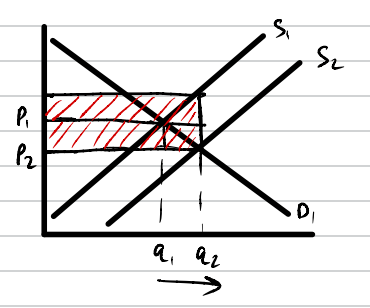- subsidy
- definition
- diagram
- link it to the market failure
- evaluation
- over-dependence on subsidy
- opportunity cost - taxpayer
A subsidy is a payment given by the government to firms, causing supply to shift to the right.
The diagram below shows the impact of a subsidy on gym membership.

The right shift in supply causes a fall in price from p1 to p2. Therefore there are more people who are willing and able to buy a gym membership so the equilibrium quantity increases from q1 to q2. This should solve the market failure linked to gym memberships, where there previously being under-consumed because people were ignoring the benefit to third parties (positive externality).
However, a subsidy may be a bad idea as it could lead to government failure. For example, the shaded rectangle shows the amount of money the government would be spending on the subsidy. This would have a huge opportunity cost - the value of the next best alternative - which could be money spent on improving the NHS or the schools. Also, firms may not pass on the value of the subsidy (the lower costs) onto consumers if firms have a lot of monopoly power in the market. Even if they did, they could become reliant on the subsidy which would mean a long-term expense for the government. The government would have to carefullly measure the size of the externality to ensure this amount of government spending is worth it.
Furthermore, a subsidy would be more likely to fail if demand is inelastic because a subsidy would barely lead to an increase in quantity because, despite the fall in price, there is not a large enough increase in quantity demanded. One reason for this may be that going to the gym is habitual and there are a low number of substitutes available. If the government have thiis information failure, it would lead to government failure - as quantity would not increase as intended from the subsidy.